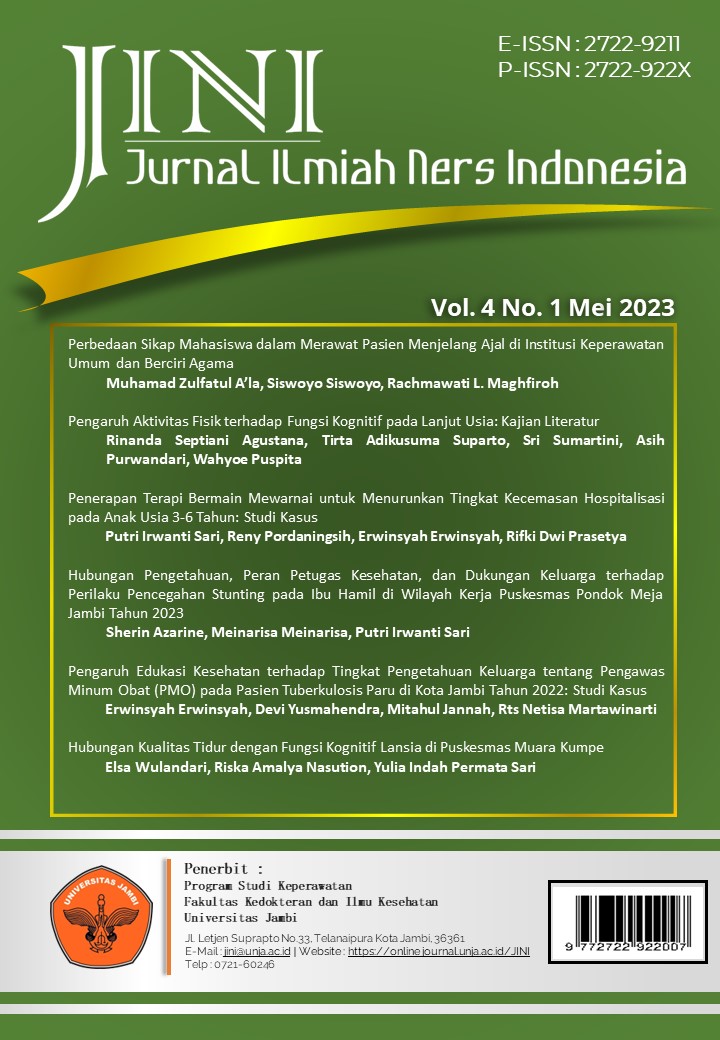Perbedaan Sikap Mahasiswa dalam Merawat Pasien Menjelang Ajal di Institusi Keperawatan Umum dan Berciri Agama
DOI:
https://doi.org/10.22437/jini.v4i1.24890Keywords:
Curricullum, Student, Attitude, Palliative CareAbstract
Students attitude towards palliative care is essential to improve the quality service for dying patients. Ideally, this positive attitudes must be flexible in interpersonal relationship and build up a direct communication, psycological relationship between patient and family, and considering of taking care of dying patients. This research determined the differences between attitude of nursing students at nursing institution with general nursing curriculum and nursing curriculum of religion in caring for dying patients. This research used stratified random sampling method and cross-sectional design. The data used Frommelt Attitudes towards the Care of the Dying Care Form B of Indonesian version (FATCOD-B-I) quesionnarrie in 102 correspondents. The result of this research showed that there is difference attitudes between nursing students from nursing institution with general nursing curriculum (104,18±7,557) and at nursing institution with curriculum of religion (99,82±8,532) in taking care of dying patients with P=0.008. The factors that affect the result is academic background, level of experience, training education of nursing students. For future to know about other factor of attitude toward caring of dying patient such as age and culture.
Â
Abstrak
Sikap mahasiswa dalam perawatan menjelang ajal merupakan hal yang esensial dalam upaya peningkatan kualitas pelayanan menjelang ajal. Idealnya, fleksibel dalam hubungan interpersonal, adanya keinginan untuk menjalin komunikasi terbuka, pemikiran psikologis yang berkaitan dengan pasien dan keluarga, dan menganggap merawat pasien menjelang ajal merupakan hal yang menyenangkan. Penelitian ini bertujuan untuk mengetahui perbedaan sikap mahasiswa dalam merawat pasien menjelang ajal di institusi pendidikan dengan kurikulum keperawatan umum dan kurikulum keperawatan berciri agama di wilayah Jember. Penelitian ini merupakan jenis penelitian deskriptif komparatif dengan desain penelitian Cross Sectional. Pengumpulan data menggunakan kuesioner Frommelt Attitudes towards the Care of the Dying Care Form B of Indonesian version (FATCOD-B-I) dengan 102 responden. Hasil dari penelitian menunjukkan bahwa terdapat perbedaan sikap mahasiswa dari institusi pendidikan dengan kurikulum keperawatan umum (104,18±7,557) dan mahasiswa dari institusi pendidikan dengan kurikulum keperawatan berciri agama (99,82±8,532) dalam merawat pasien menjelang ajal dengan P=0.008. Faktor – faktor yang dapat mempengaruhi yaitu level akademik, pengalaman dalam merawat pasien menjelang ajal, pelatihan perawatan pasien menjelang ajal. Penelitian menyarankan untuk meneliti faktor lain terkait faktor usia dan budaya yang dapat mempengaruhi sikap mahasiswa dalam merawat pasien menjelang ajal.
Kata Kunci: Kurikulum, Mahasiswa, Sikap, Perawatan Paliatif
Â
Downloads
References
A’la, M. Z. (2016). The Frommelt Attitudes toward Care Of The Dying Care Form B (FATCOD- B) Indonesia Version: Measurement validity using factor analysis in nursing students. Nurseline Journal, 1(1), 73–82. jurnal.unej.ac.id/index.php/NLJ/article/view/3832
A’la, M. Z., Setioputro, B., & Kurniawan, D. E. (2018). Nursing Student s ’ Attitudes towards Caring for Dying Patients. Nurse Media Journal of Nursing, 8(1), 25–34.
Abu-El-Noor, N. I., & Abu-El-Noor, M. K. (2015). Attitude of Palestinian Nursing Students Toward Caring for Dying Patients. Journal of Holistic Nursing.
Ali, W. G. M., & Ayoub, N. S. (2010). Nurses’ attitude toward caring for dying patient in Mansoura University Hospital. Journal of Medicine and Biomedical Sciences, 10, 16–23.
Arslan, D., Akca, N. K., Simsek, N., & Zorba, P. (2014). Student Nurses ’ Attitudes Toward Dying Patients in Central Anatolia. International Journal of Nursing Knowledge, 183–188.
Asosiasi Institusi Pendidikan Ners. (2015). kurikulum pendidikan ners 2015. AIPNI.
Bakan, A. B., & Arli, S. K. (2018). Comparison of Attitudes Toward Death Between University Students Who Receive Nursing Education and Who Receive Religious Education. Journal of Religion and Health, 1–9. https://doi.org/10.1007/s10943-018-0609-z
Barrere, C. C., Durkin, A., Lacoursiere, S., (2008). The Influence of End-of-Life Education on Attitudes of Nursing Students The Influence of End-of-Life Education on Attitudes of Nursing Students. International Journal of Nursing Education Scholarship, 5(1).
Braun, M., Gordon, D., & Uziely, B. (2010). Associations Between Oncology Nurses’ Attitudes Toward Death and Caring for Dying Patients. Oncology Nursing Forum, 37(1), E43–E49. https://doi.org/10.1188/10.ONF.E43-E49
Dobbins, E. H. (2011). The impact of end-of-life curriculum content on the attitudes of associate degree nursing students toward death and care of the dying. Teaching and Learning in Nursing, 6(4), 159–166. https://doi.org/10.1016/j.teln.2011.04.002
Dunn, K. S., Otten, C., & Stephens, E. (2005). Nursing experience and the care of dying patients. Oncology Nursing Forum, 32(1), 97–104. https://doi.org/10.1188/05.ONF.97-104
Ek, K., Westin, L., Prahl, C., Österlind, J., Strang, S., Bergh, I., & Hammarlund, K. (2014). Death and caring for dying patients: exploring first-year nursing students’ descriptive experiences. International Journal of Palliative Nursing, 20(10), 509–515. https://doi.org/10.12968/ijpn.2014.20.10.509
Enggune, M., Ibrahim, K., & Rizmadewi Agustina, H. (2014). Persepsi Perawat Neurosurgical Critical Care Unitterhadap Perawatan Pasien Menjelang Ajal. Jurnal Keperawatan Padjadjaran, v2(n1), 35–42. https://doi.org/10.24198/jkp.v2n1.5
Frommelt, K. H. M. (2003). Attitudes toward care of the terminally ill: An educational intervention. American Journal of Hospice and Palliative Medicine, 20(1), 13–22. https://doi.org/10.1177/104990910302000108
Gallagher, A., Bousso, R. S., McCarthy, J., Kohlen, H., Andrews, T., Paganini, M. C., Abu-El-Noor, N. I., Cox, A., Haas, M., Arber, A., Abu-El-Noor, M. K., Baliza, M. F., & Padilha, K. G. (2015). Negotiated reorienting: a grounded theory of nurses’ end-of-life decision-making in the intensive care unit. International Journal of Nursing Studies, 52(4), 794–803. https://doi.org/10.1016/j.ijnurstu.2014.12.003
Gillan, P. C., Riet, P. J. Van Der, & Jeong, S. (2014). End of life care education, past and present: A review of the literature. Nurse Education Today, 34, 331-342.
Grubb, C., & Arthur, A. (2016). Student nurses’ experience of and attitudes towards care of the dying: A cross-sectional study. Palliative Medicine, 30(1), 83–88. https://doi.org/10.1177/0269216315616762
Henoch, I., Browall, M., Melin-Johansson, C., Danielson, E., Udo, C., Sundler, A. J., Björk, M., Ek, K., Hammarlund, K., Bergh, I., & Strang, S. (2014). The Swedish version of the frommelt attitude toward care of the dying scale: Aspects of validity and factors influencing nurses’ and nursing students’ attitudes. Cancer Nursing, 37(1), 1–11. https://doi.org/10.1097/NCC.0b013e318279106b
Iranmanesh, S., Axelsson, K., Häggström, T., & Sävenstedt, S. (2010). Caring for dying people: attitudes among Iranian and Swedish nursing students. Indian Journal of Palliative Care, 16(3), 147–153. https://doi.org/10.4103/0973-1075.73643
Jafari, M., Rafiei, H., Nassehi, A., Soleimani, F., Arab, M., & Noormohammadi, M. R. (2016). Caring for dying patients: attitude of nursing students and effects of education. Indian Journal of Palliative Care, 21(2), 192–197. https://doi.org/10.4103/0973-1075.156497
Karadag, E., Parlar, S., Ozlem, K., Merve, U., & Akyol, A. (2018). Attitudes of Nurses in Turkey Toward Care of Dying Individual and the Associated Religious and Cultural Factors. Journal of Religion and Health. https://doi.org/10.1007/s10943-018-0657-4
Lange, M., Thom, B., & Kline, N. E. (2008). Assessing Nurses’ Attitudes Toward Death and Caring for Dying Patients in a Comprehensive Cancer Center. Oncology Nursing Forum, 35(6), 955–959. https://doi.org/10.1188/08.ONF.955-959
Leombruni, P., Miniotti, M., Bovero, A., Zizzi, F., Castelli, L., & Torta, R. (2013). Attitudes toward caring for dying patients: An overview among Italian nursing students and preliminary psychometrics of the FATCOD-B scale. Journal of Nursing Education and Practice, 4(3), 188–196. https://doi.org/10.5430/jnep.v4n3p188
Lippe, M. P., & Becker, H. (2015). Improving Attitudes and Perceived Competence in Caring for Dying Patients: An End-of-Life Simulation. Nursing Education Perspectives, 36(6), 372–378. https://doi.org/10.5480/14-1540
Lundmark, M. (2006). Attitudes to spiritual care among nursing staff in a Swedish oncology clinic. Journal of Clinical Nursing, 15(7), 863–874. https://doi.org/10.1111/j.1365-2702.2006.01189.x
Mutto, E. M., Cantoni, M. N., Rabhansl, M. M., & Villar, M. J. (2012). A Perspective of End-of-Life Care Education in Undergraduate Medical and Nursing Students in Buenos Aires, Argentina. Journal of Palliative Medicine, 15(1), 93–98. https://doi.org/10.1089/jpm.2011.0238
Wang, L. P., Li, Y. J., Yan, W. Z., & Li, G. M. (2016). Development and Psychometric Testing Chinese Version of the Frommelt Attitude Toward Care of the Dying Scale, Form B in Nurses and Nursing Students. Journal of Cancer Education, 31(1), 123–130. https://doi.org/10.1007/s13187-015-0810-7
WHO. (2014). Global Atlas of Palliative Care at the End of Life (S. R. Connor & M. Cecilia Sepulveda Bermedo (eds.)). WHO.
Yaqoob, M., Nasaif, H., & Kadhom, H. (2018). Undergraduate final year nursing students ’ attitudes toward caring for dying patients: Bahrain’s experience.
Downloads
Published
How to Cite
Issue
Section
License
Copyright (c) 2023 Jurnal Ilmiah Ners Indonesia

This work is licensed under a Creative Commons Attribution-NonCommercial-ShareAlike 4.0 International License.
Jurnal Ilmiah Ners Indonesia (JINI) memberikan akses terbuka terhadap siapapun agar informasi dan temuan pada artikel tersebut bermanfaat bagi semua orang. Semua konten artikel Jurnal ini dapat diakses dan diunduh secara gratis, tanpa dipungut biaya, sesuai dengan lisensi creative commons yang digunakan.

Ciptaan disebarluaskan di bawah Lisensi Creative Commons Atribusi-BerbagiSerupa 4.0 Internasional.















